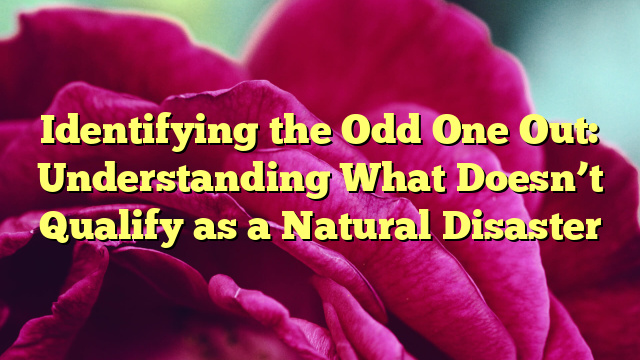Identifying the Odd One Out: Understanding What Doesn’t Qualify as a Natural Disaster
“`html
Identifying the Odd One Out: Understanding What Doesn’t Qualify as a Natural Disaster
Natural disasters are catastrophic events with atmospheric, geological, and hydrological origins that can cause fatalities, property damage, and social environmental disruption. However, not all disastrous events fall under the category of natural disasters. This article aims to clarify what constitutes a natural disaster and highlight events that, despite their devastating effects, do not qualify as natural disasters.
What Qualifies as a Natural Disaster?
Natural disasters are significant events resulting from natural processes of the Earth. These include:
- Geological disasters: Earthquakes, volcanic eruptions, landslides, and tsunamis.
- Meteorological disasters: Hurricanes, tornadoes, blizzards, and droughts.
- Hydrological disasters: Floods and avalanches.
- Biological disasters: Epidemics and plagues (though their classification can vary).
Events That Do Not Qualify as Natural Disasters
While the impact of the following events can be devastating, they do not fall within the definition of natural disasters:
1. Man-Made Disasters
Disasters caused by human actions, whether intentional or accidental, do not qualify as natural disasters. Examples include:
- Industrial accidents
- Oil spills
- Nuclear meltdowns
- Terrorist attacks
2. Technological Failures
Failures of technological systems due to human error, malfunction, or design flaws are not considered natural disasters. These can include:
- Power outages
- Bridge collapses
- Internet outages
3. Pandemics
While pandemics result from biological agents, their spread is often exacerbated by human actions and global interconnectedness, placing them in a gray area between natural and man-made disasters.
Comparing Natural and Man-Made Disasters
To further understand the distinction, let’s compare the characteristics of natural and man-made disasters:
| Aspect | Natural Disaster | Man-Made Disaster |
|---|---|---|
| Origin | Natural processes of the Earth | Human actions or technological failures |
| Examples | Earthquakes, hurricanes, floods | Industrial accidents, terrorist attacks, nuclear meltdowns |
| Prevention | Limited to mitigation and preparedness | Often preventable through safety measures and regulations |
Why the Distinction Matters
Understanding the difference between natural and man-made disasters is crucial for several reasons:
- Response and recovery efforts: The nature of the disaster influences the type of response and recovery strategies implemented.
- Insurance and compensation: Insurance policies and compensation mechanisms often distinguish between natural and man-made disasters.
- Prevention and mitigation: Recognizing the human role in certain disasters can lead to better prevention, regulation, and mitigation strategies.
Conclusion
While the line between natural and man-made disasters can sometimes blur, especially with events like pandemics, it’s important to recognize the fundamental differences in their origins and impacts. Understanding what does not qualify as a natural disaster helps in preparing for, responding to, and mitigating the effects of these devastating events. By acknowledging the human role in certain disasters, society can take proactive steps towards prevention and resilience.
“`

